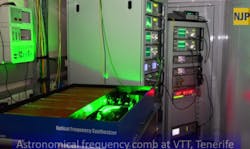Researchers at Max Planck Institute of Quantum Optics (Garching, Germany) and other institutions have demonstrated how a solar telescope can be combined with a laser frequency comb (LFC) to allow spectral analysis of distant stars with unprecedented accuracy, which can potentially aid the hunt for exoplanets, as well as allow improved observations of the Sun and the measurement of the accelerating universe by observing distant quasars.
A laser frequency comb is formed by creating a precisely timed train of ultrafast laser pulses; such an output is entirely equivalent to a continuous-wave beam that has a very large frequency comb with teeth evenly spaced apart in frequency. This comb can be used as a ruler to precisely measure the frequency of light from a wide range of sources, such as lasers, atoms, or stars.
Beginning with measurements of the Sun
In their study, the researchers performed an analysis on the Sun by combining sunlight from the Kiepenheuer Institute's solar telescope in Tenerife (Canary Islands) with the light of an LFC. Both sources of light were injected into a single-mode optical fiber that delivered the light to a spectrograph for analysis with perfect spatial mode matching of both light sources in the fiber, which maximizes the ability to accurately measure the sunlight spectrum (and absorption lines in the Earth's atmosphere).
Using the technique, the researchers measured the well-known 5 minute radial-velocity oscillation in the Sun. While the current setup is limited to solar spectroscopy, refinements can enable spectroscopic measurement of starlight with the same technique.
"Our results show that if the LFC light and the sunlight are simultaneously fed through the same single-mode fiber, the obtained calibration precision improves by about a factor of 100 over a temporally separated fiber transmission," says lead author Rafael Probst of the Max Planck Institute of Quantum Optics. "We then obtain a calibration precision that keeps up with the best calibration precision ever obtained on an astrophysical spectrograph, and we even see considerable potential for further improvement."
For exoplanet hunts in which the radial velocity of a star is measured over time to spot cyclic variations, and thus the influence of exoplanets, the researchers state that they can measure a change in speed of roughly 1 m/s over large time periods; in contrast, an LFC could enable measurements with an accuracy of 1 cm/s.
Partners
The work is a collaboration comprising the Max Planck Institute of Quantum Optics, the Kiepenheuer Institute for Solar Physics (Freiburg, Germany), and the University Observatory Munich (Munich, Germany). Among the contributors are guest scientists from the National Astronomical Observatories of China in Beijing; Menlo Systems (Martinsried, Germany) is part of the collaboration as an industrial partner.
REFERENCE:
1. R. A. Probst et al., New Journal of Physics (2015); http://iopscience.iop.org/1367-2630/17/2/023048 (paper can be downloaded from this site)

